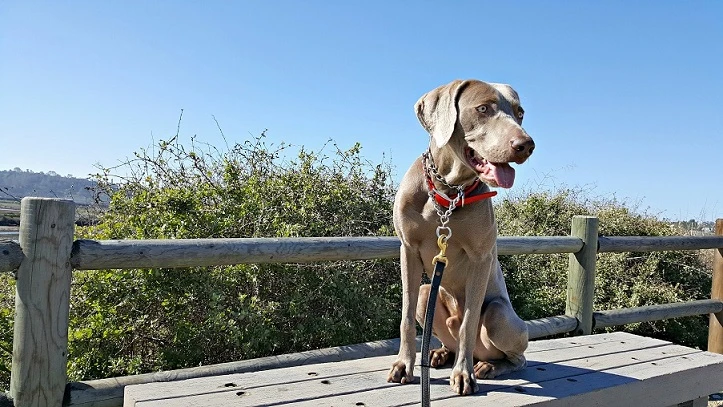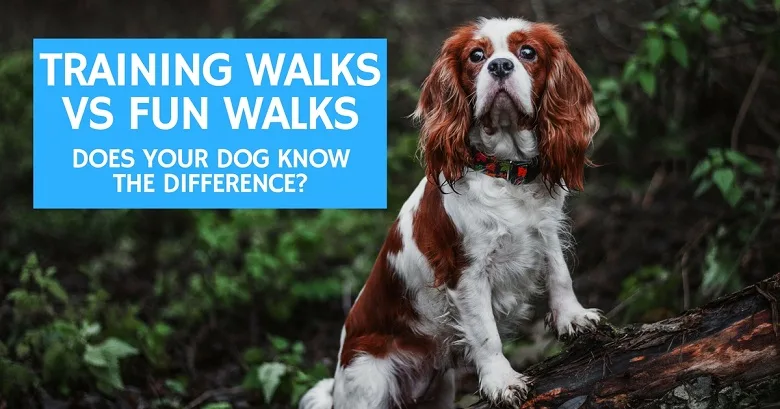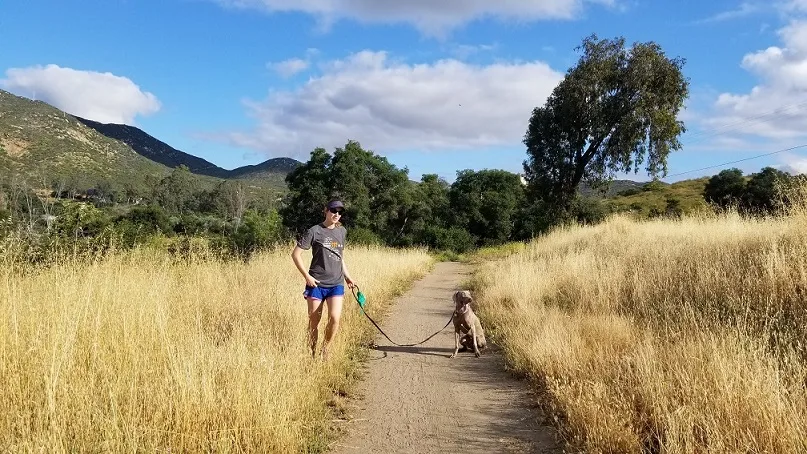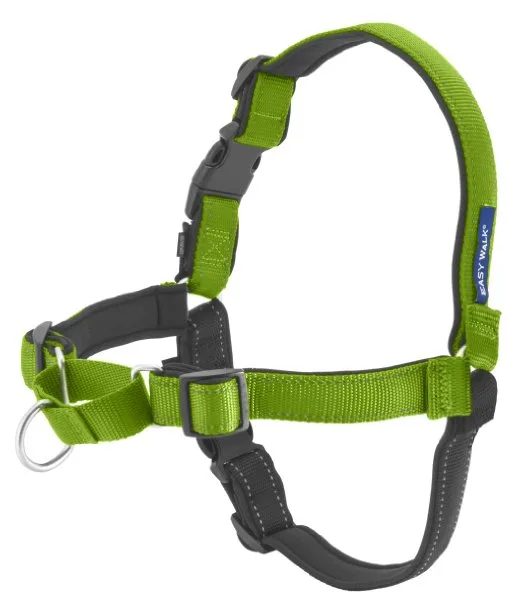Rotating between training walks vs fun walks
When I walk my weimaraner Remy, I try to rotate between training him to walk at my side and giving him freedom to walk in front.
Most dog trainers seem to think it’s OK to rotate between “training” and “freedom” because it’s unreasonable to expect a dog to heel or walk perfectly at your side for an entire 60-minute walk.
Heck, it’s hard for some dogs to focus for even 2 minutes! We’re asking them to walk painfully slow and ignore everything interesting.
So, my questions to you are:
1. Do you rotate between “training” and “freedom” on your dog walks?
2. How do you communicate to your dog the difference between the two?
First I want to comment that I don’t think it’s as simple as “training” vs. “freedom.” Remy and I have at least 3 different “modes” on our walks.

We have 3 walking modes:
Mode 1: True training walks. This is where Remy and I are both really focused and we work on heeling and obedience commands like stand, stay and down. We do this for about 10 minutes most mornings.
Mode 2: Power walks where I hold Remy at “heel.” To be honest, he’s pulling almost the entire time when we do this. I still tell him “heel” but I’m keeping him in place with a tight leash. About 50% of our walks are like this, so a good 3 hours per week.
Mode 3: Freedom walks. I let Remy walk in front of me, pee on things, sniff, etc. He’s usually pulling, although not hard. This makes about the other 50% of our walks, so at least 3 hours per week.
I wanted to point out the above to give you an idea of what our walks look like. It’s not so simple as “training” vs “freedom” because of those walks where I’m holding him at a heel.
*In the comments, let me know if you have similar “modes” and how often do you spend time in each?

How does your dog know when it’s OK to “check out” from training?
Here are two ideas that can potentially make things clearer for you both:
1. Use two different commands/cues.
One word for when you want your dog to walk at your side. One word for when you want to let your dog take a break.
My words are “HEEL” for working on heeling and “BREAK” to signal take a break.
I usually say it’s best not to repeat a command, but when working on “Heel” I repeat it a lot. I also repeat “Break” when I want my dog to have freedom.
2. Choose two collars or a harness and a collar.
Clip the leash to one collar or harness for training and to the other collar or harness when you’re not training.
My friend who is a professional dog trainer (Hi, Christine!) suggested it can be helpful for a dog if you clip the leash to the front of your dog’s harness for training and to the top of a harness when you’re not training.
What do you guys think? Would this be helpful for your dog?
For example, she said she uses the Freedom harness for her dog because it has a ring for the leash in two places – at the dog’s chest and on the dog’s back. So with that one tool she can easily switch the leash from one spot to the other.
Most of us don’t use a Freedom harness (you can order one here), but the same concept could apply with any two collars or a harness. Christine is a positive reinforcement trainer, and she highly recommends the Freedom harness.
I’m trying this concept using a harness and a collar.
I have an EasyWalk harness, which is also designed to limit a dog’s pulling. It has a ring for the leash at the dog’s chest.
For the last 2 weeks, I’ve been having Remy wear his harness and prong collar at the same time, and I clip the leash to one or the other depending on what we’re doing. You could use whatever collar you want – a flat nylon collar, a slip collar or a Gentle Leader.
When I want Remy to remain at my side, I keep the leash clipped to his prong collar and say “Heel.”
When I want to give Remy freedom to walk in front, I clip the leash to his harness and say “Break!”
After trying this for a week, it has removed stress for ME.
Physically switching the leash gives me permission to check out from training.
Rotating between the two tools has definitely helped Remy and I both feel more relaxed.
When we’re working, we’re working. When we’re not, we’re not!
This reminded me of how some working dogs (guide dogs, police K9s, etc.) wear a harness or vest when they’re working or training. This helps signal to the public that the dog is working but it’s also a signal to the dog.
There are cons to using this method:
1. There are risks to clipping the leash on and off. Some dogs might dart away if you’re not careful. (Be careful!)
2. Your dog has to wear more gear. Remy wears his flat nylon collar, his prong collar and his harness so it gets to be a lot! No big deal in our case but it could get annoying depending on what you’re doing.
Sometimes if I know I’m not going to work on training I just leave the prong collar home and we use the harness the whole time or vice versa.
I also want to mention, you can use whatever two collars/harnesses/tools you want.
You don’t have to use a harness. You could use a Gentle Leader or a Halti for training and your dog’s flat collar for freedom walks. Or any combination. Your dog will likely pick up on the difference if you’re consistent.

Now, I’m curious what the rest of you think of these ideas.
Would you use two different collars? One for training and one for freedom? Or do you think that’s making it overly complicated? I’m not sure if I will continue it or not, it’s just something I’m trying for a few weeks.
Do you use two different commands/cues for training walks vs. freedom?
Let me know in the comments! Thank you for reading and participating. Please share this post with others if you found it helpful.
-Lindsay
Other resources:
- Using pulling to your advantage (The website, Just Weimaraners)
- Making leash manners fun (Dr. Patricia McConnell)
- How to stop a dog from pulling (That Mutt)
- I can’t stop when my dog pulls because she needs the exercise (That Mutt)
- The best collar for extreme pullers (That Mutt)


Ken Smith
Tuesday 30th of January 2018
I follow a similar routine, using "come" (this command is used for recall as well as heeling: this is the basis of e-collar training used by SitMeansSit dog trainers) and "go". Go on leash means do what you want, off leash it means go play !
Susie
Tuesday 30th of January 2018
With my BC, all our walks are a mix of training and fun/freedom. I think of the walk as 'his time' and think it's important for him to have time to be able to run and sniff freely without me nagging him all the time! However we do stop to do training outside on our walks on every walk and I kind of think of everything being training- someone said once that whatever you do with a dog/all their experiences are teaching them something, so it's important to be teaching them what you want them to be learning, and I liked that.
Patch is only on his lead for short periods- on roads and pavements mainly, but I always make him walk nicely, although not to heel as such. We have a command for heel but don't use it all the time on lead, more off lead when needed...think it would get tiring for us both if we did! As long as he's not pulling, that's fine by me. I think he'd be very confused and slower to learn if I let him pull sometimes, but maybe that's different for different dogs. Also it would really hurt me if he pulled... Can't imagine how hard it must be/painful walking a bigger dog if they pull!
I've heard a lot of people in the USA mention leash laws but don't understand what they are. I know it's something to do with dogs having to be on lead but whereabouts and in what situation? Is it just certain states? Is it all the time they have to be on lead? Feel very lucky we have more freedom in the UK-my BC would go nuts if he had to be on the lead all the time!
Forgot to mention- I've not done it myself but heard of a lot of people using different leads to signify if the dog is allowed more freedom or has to walk nicely. Apparently it works well a lot of the time. Also people using harnesses for running so the dog knows they can pull but only in the harness.
Thanks for another interesting post!:)
Lori Hilliard
Friday 3rd of November 2017
My own dog is so old that he walks slowly all the time, but I do have trouble with him getting distracted by certain things - he gets so excited when he see another dog and begins pulling. I think a harness instead of his collar will help. But a new command word is in order that will mean "leave the other dog alone." I guess I'm going to be teaching my old dog some new tricks!
Barbara Rivers
Saturday 14th of October 2017
I really like the idea of switching back and forth between the two because, as you said, it's unrealistic to expect a dog to always walk at a heel. They're dogs, after all, and enjoy exploring all those interesting sniffs that are out there. That being said, I definitely do expect my pups to listen when I ask them to walk next to me. I use "focus" for that purpose.
I really, really like the idea of using a harness with two clips to train a dog between the two different walks. We don't have the Freedom harnesses, but our Ruffwear harnesses also have a leash attachment in the front and one on the back.
Karen
Friday 13th of October 2017
Also the 15' leash I have seen (and they are hard to find ) is only about 3/4 " wide. My pup is very strong pit mix I don't know if that size is strong enough Ideas ?
Lindsay Stordahl
Friday 13th of October 2017
Mighty Paw is a sponsor of my blog, and they have one that is 1 inch by 15 feet. It is nylon. I haven't used this particular leash.
http://amzn.to/2yKnRha